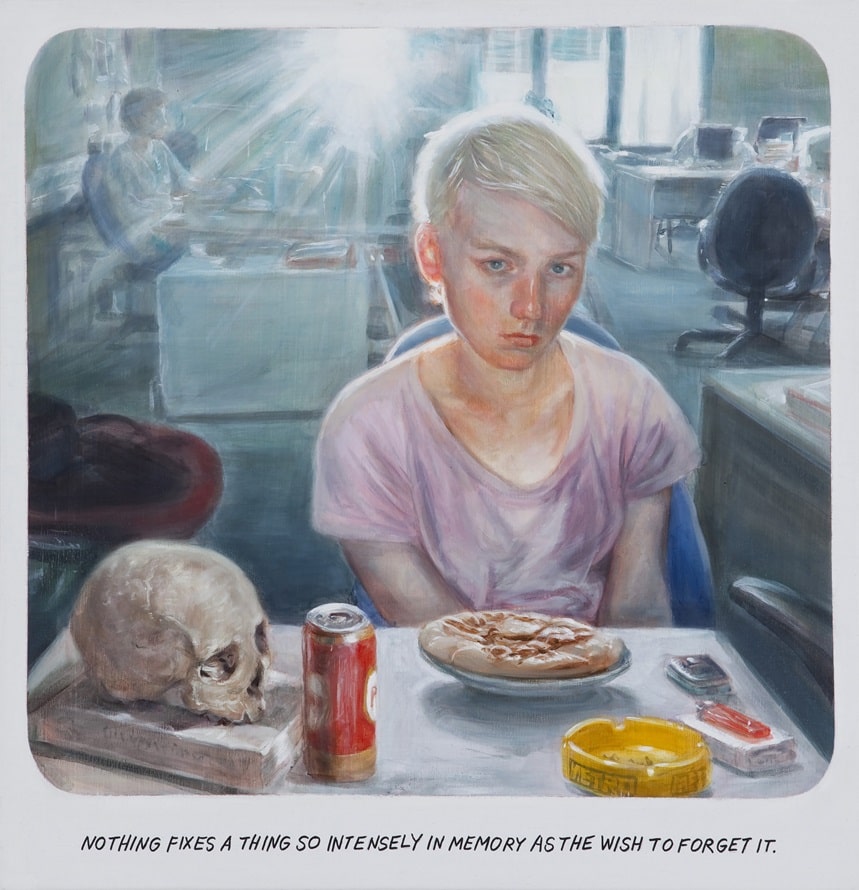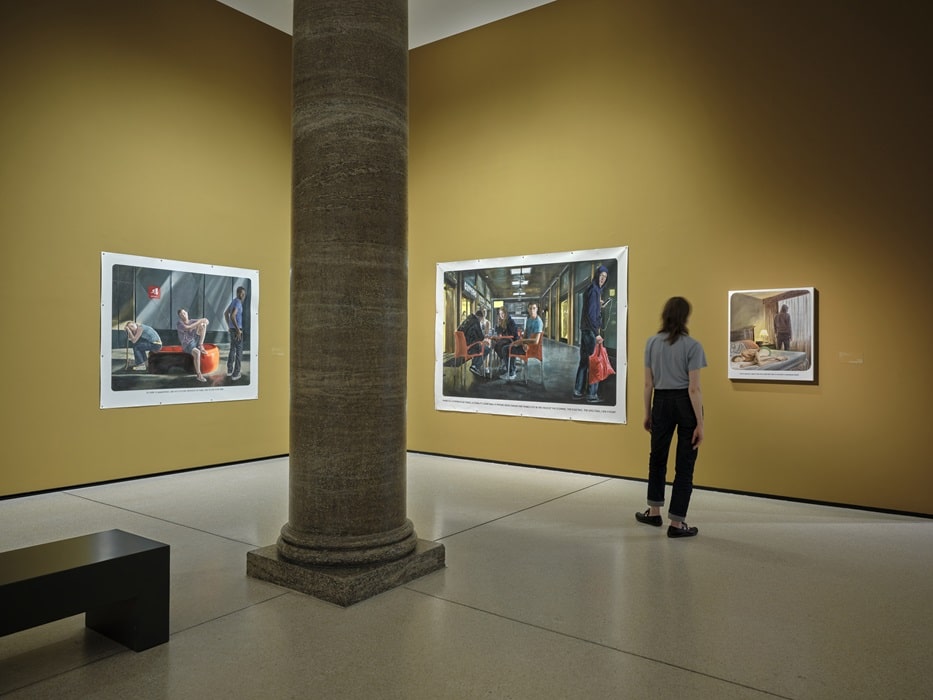Städel Museum is currently showing the exhibition MIRROR OF THOUGHTS by the artist duo Markus Muntean and Adi Rosenblum. The two artists Markus Muntean (b. 1962) and Adi Rosenblum (b. 1962) have been working together since the 1990s. In their primarily painterly oeuvre, they impressively combine their identities to create one artistic signature. The Städel Museum is dedicating a solo exhibition in its Contemporary Art Collection to the artist duo, featuring a video work and eleven large-format paintings – including two new works – whose settings are places of transit: shopping centres, airport terminals, hotels, or offices. Immersed in their own thoughts, the young protagonists stare intently at their smartphones or gaze into the distance, are in motion or look out at the viewer with boredom or irritation.
Image above: Muntean/Rosenblum (both*1962), Untitled (“Knowledge would not necessarily…”), 2023, Oil, pastel chalks on canvas, 195 x 293 cm, Jorge M. Pérez Collection, Miami, © Muntean/Rosenblum, Photo: © Sandro E.E. Zanzinger Photographie 2023
The work of Muntean/Rosenblum fluctuates between the influences of past art periods and contemporary pop-cultural phenomena. While their compositions are firmly anchored in the pictorial memory of art history, referencing well-known masterpieces from the Renaissance to Modernism, their figures are taken entirely from the present. They stem from an image archive established over many years, fed by photographs from lifestyle magazines, the Internet, and their own photo shoots. The artist duo uses this rich pool of images as a basis for creating peculiar scenes through the medium of painting: Set against anonymous urban backdrops, the dramatically arranged young people look like isolated extras in a contemporary stage play. Strange and at the same time familiar in their composition, the paintings reflect an atmosphere of lethargy and indifference. It is a painful yet liberating moment that marks the transition from adolescence to adulthood – a state of limbo. As if looking through a magnifying glass, Muntean/Rosenblum address central themes of our time: the ambivalence of human existence, the growing insecurity of the individual, and a pervasive sense of transience.
Philipp Demandt, Director of the Städel Museum: ‘With their interlinking of past and present, the works of the artist duo Muntean/Rosenblum fit perfectly into the Städel Museum’s collection, which spans more than 700 years of art. As a museum of pictures, we focus on painterly positions with regularly changing exhibitions in the Contemporary Art Collection and thus follow how painting expands, redefines itself, and breaks new ground across epochs. The art of Muntean/Rosenblum epitomises this borderline and tightrope walk of painting in contemporary art: drawing on photographs, they create surreal, collaged paintings at the interface between conceptual art and figurative genre painting.’

Svenja Grosser, Head of the Contemporary Art Collection and curator of the exhibition, adds: ‘Non-places underpin Muntean/Rosenblum’s working principle, which is primarily concerned with the possibilities of figurative painting. The artist duo’s decision to draw their motifs from an archive and to abandon their respective identities in favour of a joint signature already poses a challenge to painting, namely the lack of authorship. The concept of non-places is the logical extension of these considerations. As Muntean/Rosenblum take great care to deprive their works of a thematic statement, the viewer is challenged in his or her own perception: What does one want to see? How does one interpret the scene? What is real and what is not? The painting unfolds in this field of tension, between these poles, and is thus perhaps even closer to abstraction than to figuration.’
The pictorial worlds of Muntean/Rosenblum oscillate between reality and illusion. While the scenes in their paintings appear to be coherent at first glance, certain details reveal that they could never have taken place in this way: the looks and actions of the people portrayed deviate unnaturally from one another, overlap, and do not fit into the depicted situation. This effect results from the process of creating the paintings, in which material from the artist duo’s image archive is first combined into a digital collage and then transferred to the canvas. The artist duo rarely stretches the canvases, which can measure up to five metres in width, on frames, but instead pins them directly to the wall. The reference of their compositions to important works of art history is sometimes more, sometimes less obvious, for example through the use of concrete motifs or subtle allusions, such as the use of central perspective as the greatest achievement of painting since the Renaissance.

Muntean/Rosenblum’s depictions are not to be understood in terms of photorealism. The framing with a white border, similar to a comic strip, further emphasises the illusionism of painting as a ‘window to the world’. In the lower part of the paintings, succinct quotations from literary works by authors such as Fyodor Dostoyevsky, Deborah Levy, Rebecca Solnit, and Virginia Woolf open up a further, fascinating level, which, however, does not establish a direct link between image and text and thus denies any reliable approach to interpretation. Instead, it invites the viewer to fill and expand the space created with his or her own thoughts and associations. The title of the exhibition at the Städel Museum is taken from the work Untitled (“The earth is literally a mirror …”) (2019). It is a quotation from Saul Bellow’s 1970 novel Mr Sammler’s Planet: ‘The earth is literally a mirror of thoughts. Objects themselves are embodied thoughts. Death is the dark backing that a mirror needs if we are to see anything.’
The places of transit, as they appear in the works in the exhibition Mirror of Thoughts, are also referred to as non-places. According to the French anthropologist Marc Augé, they have neither an identity of their own nor a specific history or relationship. They harbour a certain ambivalence, which is reflected in the concept of the works. People who spend time in airports, waiting rooms, tube stations, hotels, or offices, enter into a contract – for example, when they buy a plane ticket. They lose their status as individuals and become guests, passengers, or customers.
The young people in Muntean/Rosenblum’s paintings also have no identity. They have been erased in the working process: deprived of their original task, they are not assigned a new action in the new pictorial context either. For example, the posture of the central figure in Untitled (“What lies ahead …”) (2023) does not fit into the situation at the airport. In the works of Muntean/Rosenblum, inconspicuous details suggest a transformation from individual subject to pure object. The emergency exit sign in Untitled (“To hope is dangerous …”) (2023), for example, is addressed to every person who sees it, and the ATM in Untitled (“It’s the tragedy of …”) (2016) also communicates equally with everyone. An enigmatic hotel scene in Untitled (“To go wrong …”) (2010) shows the extent to which the resulting anonymity can be associated with loneliness. Although the two figures are in a private space, there is no personal relationship between them. With the open-plan office in Untitled (“Nothing fixes a thing …”) (2010), the artist duo provides a fitting stage for the objectification of the human being, who here becomes a mere employee without a personality.

Muntean/Rosenblum’s oeuvre also includes performance and video art. The film This Is Not An Exit (2017, 3:13 min.), presented in the exhibition, tells the story of how much strength and effort it can take to develop and shape one’s own identity. On an abandoned building with its modern architecture, the artist duo stages two parkour runners who at times appear serious and exhausted. They can be seen during breaks or shortly before their actual activity, accompanied by a specially composed, repetitive soundtrack that reproduces fragments from Gertrude Stein’s novel The Making of Americans. Published in 1925, the story focuses on the history and development of American families and individual personalities, making the point that a person’s identity is determined not only by their individual characteristics, but also by the relationships and connections they have with other people.
Markus Muntean (b. 1962 in Graz, Austria) and Adi Rosenblum (b. 1962 in Haifa, Israel) have been collaborating since 1992 and live in Vienna. Their work has been presented internationally in solo exhibitions, including at the Albertina, Vienna, Austria (2022); the Museum of Contemporary Art, Kraków, Poland (2018); the Museo de Arte Contemporáneo, A Coruña, Spain (2018); the Parkview Museum, Beijing, China (2017); the Galerie für Zeitgenössische Kunst, Leipzig, Germany (2007); and the Museo de Arte Contemporáneo de Castilla y León, León, Spain (2006). The artist duo is represented in numerous collections, including those of The Museum of Modern Art, New York, USA; the Museo de Arte Contemporáneo de Castilla y León, Léon, Spain; the Museum of Contemporary Art, Kraków, Poland; the Museum Kunstpalast, Düsseldorf, Germany; the Tel Aviv Museum of Art, Tel Aviv, Israel; and the Museum moderner Kunst Stiftung Ludwig Wien, the Belvedere 21er Haus, the Albertina, and the Museum für angewandte Kunst, Vienna, Austria.
WHEN?
Exhibition period: Friday, 3. May until Sunday, 1. December 2024
Openong hours:
Tue, Wed, Fri, Sat, Sun + holidays: 10.00 am – 6.00 pm
Thu: 10.00 am – 9.00 pm
WHERE?
Städel Museum
Schaumainkai 63
60596 Frankfurt am Main
COSTS?
Tue – Fri:
Regular: €16
Reduced: €14
Sat, Sun + holidays
Regular: €18
Reduced: €16
every Tuesday from 3.00 pm
Regular: €9
free admission for children under 12.
Groups of 10 or more (non-concession adults): €16 per person






